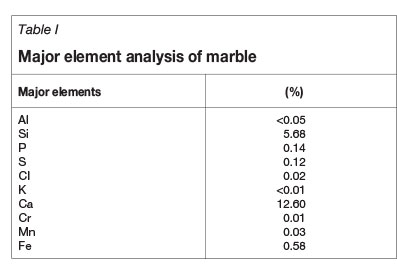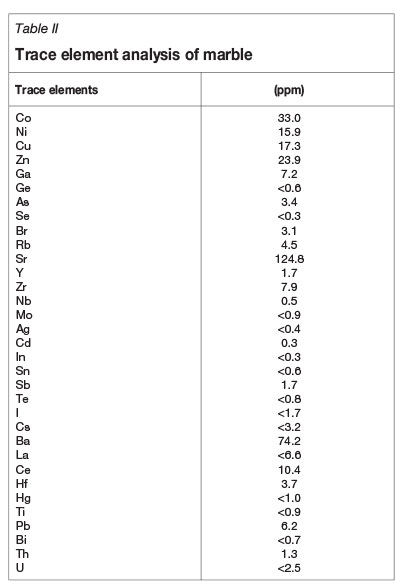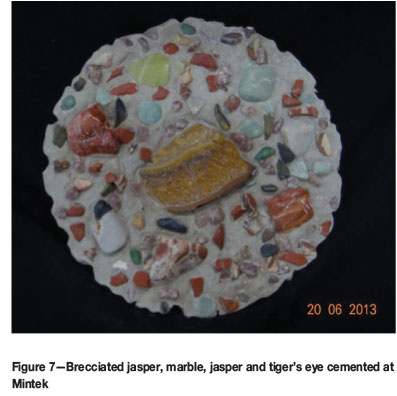Services on Demand
Article
Indicators
Related links
-
 Cited by Google
Cited by Google -
 Similars in Google
Similars in Google
Share
Journal of the Southern African Institute of Mining and Metallurgy
On-line version ISSN 2411-9717
Print version ISSN 2225-6253
J. S. Afr. Inst. Min. Metall. vol.114 n.11 Johannesburg Nov. 2014
GENERAL PAPERS
Beneficiation of marble from Griekwastad, Northern Cape Province
N.P. Mahumapelo; C. Magaseng
Mintek, South Africa
SYNOPSIS
This paper is based on a study to determine the potential beneficiation opportunities for marble from Griekwastad in the Northern Cape Province. The marble was characterized mineralogically by X-ray diffraction. Major and trace elements were determined using inductively coupled plasma-optical emission spectroscopy. The sample was crushed, and the crushed material beneficiated by tumbling and polishing. The resulting beads were incorporated into a variety of jewellery and other decorative items. It is concluded that the beneficiation of Griekwastad marble presents a good opportunity for value addition and job creation, provided that an effective marketing strategy for the products can be developed.
Keywords: Griekwastad, beneficiation, marble, chemical analysis.
Introduction
The main economic activities in the Northern Cape Province are farming and mining. Mining activities are concerned mainly with iron and manganese. Diamonds, zinc, and lead are also mined in the province. Other important commodities mined in the region include copper, limestone, gypsum, rose quartz, tiger's eye, mica, verdite, and semi-precious stones. To a large extent, the beneficiation of these metals and minerals takes place outside the province.
Opportunities therefore exist to establish beneficiation plants to add value to these minerals within the Northern Cape, in this case in Griekwastad. The potential spinoffs are job creation, rural development, infrastructure development, and skills development.
The Small Scale Mining and Beneficiation (SSMB) division at Mintek was established to promote mineral-basedactivities in rural and marginalized communities through technical assistance and skills development. This is done by developing technologies appropriate for small, medium, and micro enterprises (SMMEs) that participate in the minerals and mining industry. The SSMB division's mandate is to initiate poverty alleviation programmes and support the growth of SMMEs in the mining and mineral sector. The division uses Mintek's high-technology facilities and resources to support SMMEs in mining, extraction, and value addition to minerals through beneficiation. Mineral beneficiation has been identified as an important mechanism to further diversify South Africa's economy, and thereby also create jobs. Potential benefits include employment creation, skills development and transfer, rural development, and poverty alleviation (Paul, 2011).
The Griekwastad community
Griekwastad is a town in the Northern Cape Province of South Africa (Figure 1).

Members of the Griekwastad community mine marble at a subsistence level. The use of children in mining, though undesirable, is mainly driven by poverty in the area. Children are employed in small-scale mining elsewhere in South Africa and Africa, in many cases close to where their parents are working. The mining is carried out illegally, and the miners do not have any formal training in mining and use low-technology methods.
The Department of Trade and Industry, Mintek, the Department of Mineral Resources, the Small Enterprise Development Agency, and the Pixley ka Seme District Municipality are collaborating to develop the Griekwastad community. This will be achieved by:
> Creating employment opportunities
> Provision of state funds for equipment, training, and marketing of products (Department of Trade and Industry)
> Assisting communities to apply for mining permits (Department of Mineral Resources)
> Making buildings available for projects (Pixley ka Seme District Municipality)
> Facilitating registration of informal groups as cooperatives (Small Enterprise Development Agency)
> Evaluation of mineral samples and training the community on safety measures and marble benefi-ciation (Mintek).
Objective
The objective of this study was to determine the potential beneficiation opportunities for the marble that is mined in the Griekwastad area.
Methodology
The study covered the activities summarized in Figure 2.

Mintek personnel participated in a visit to the Precious Stone and Jewellery Services CC site situated in Griekwastad to interview members and obtain samples for analysis.
A literature study was undertaken to develop a deeper understanding of the marble that is available in the Griekwastad area.
Sample preparation
The samples were crushed with a jaw crusher to 20.5 mm. The crushed marble was split into 6 kg portions and tumbled in a roller mill with steel balls (30 mm, 40 mm, and 50 mm) and 100 ml of water for one day to remove rough edges.
XRD
A pulverized portion of the marble sample was analysed by X-ray diffraction (XRD) in order to identify the minerals present and their relative proportions. This was aimed at an improved understanding of the physical properties that could affect the behaviour during beneficiation. The conditions for XRD analysis were Cu Ka radiation, a 28-scan range of 5-80°, a step size of 0.02° 28, and a counting time of 3 seconds per step. Only crystalline phases in amounts sufficient to diffract (usually 3-4 mass%) under the conditions employed are detectable (Clark, 2013).
Chemical analysis
The crushed marble sample was separately pulverized and submitted to the Analytical Services Division at Mintek for chemical analysis by inductively coupled plasma-optical emission spectroscopy (ICP-OES).
Sieve analysis
Sieve analysis is a method of determining the particle size distribution, which is usually expressed as the weight percentage retained upon each of a series of standard screens of decreasing mesh size. The particle size distribution of the crushed sample is shown in Figure 4.


The sieved marble samples in each of the size fractions were used to manufacture a product e.g. the sample retained on the 6 mm sieve was used in a necklace (see Figure 6).


Polishing
An AP1 Struers polishing machine was used to polish the samples. During polishing the operator must hold the sample carefully, because the wheel of the polishing machine rotates at high speeds. Only thick samples were polished for safety reasons.
> First, an 80-grit abrasive, which is coarse, was placed on the polishing wheel. The technician held the sample while the wheel was rotated for 3 minutes. Water was used as a lubricant and dust suppressant. The same procedure was then carried out on the opposite surface of the sample
> Secondly a 220-grit abrasive, which is medium, was used
> Lastly an 800-grit, which is fine, was used to achieve a smooth finish.
Product manufacture
The samples were incorporated into value-added products, using different techniques.
> To form beads from marble, a jewellery drill with a 1.2 mm bit was used to drill holes in each marble fragment
> The necklace and earrings were hand-made with different sizes of marble fragments
> The decorated T-shirt was made by sewing the marble to the T-shirt with a needle and thread
> The ring was made by attaching the polished marble fragment onto the prefabricated metal ring with epoxy
> A cement frame was formed by placing stones into a cement mould.
Results
Field visit
Mintek personnel visited the project site and interviewed members of Precious Stone and Jewellery Services CC. Questions were asked regarding safety aspects, knowledge of stone beneficiation, pricing, marketing, and the impact of mining marble on the environment. The findings were recorded and additional information was obtained telephon-ically at a later stage. The findings from the field visit were as follows:
> The Griekwastad community has been mining stones for generations. Knowledge has been passed down from generation to generation
> The workers lack knowledge of the safety and health precautionary measures that need to be followed when mining and beneficiating semi-precious stones
> People do not seem to be aware of environmental factors and the impact of their activities on the environment
> Old or traditional methods are still used to mine precious stone and there is little or no knowledge of beneficiation
> People are not aware of hazardous minerals that occur together with semi-precious stones
> Due to the remoteness of Griekwastad, potential clients may be unable to access the products of the industry easily
> The unemployment rate in the area affects local sales; people buy food rather than jewellery, and therefore a market outside the area must be found.
Literature review
Marble is a metamorphic form of limestone, composed mostly of either calcite or dolomite. Marble may also contain varying amounts of minerals such as chlorite, serpentine, garnet, and wollastonite, depending on the composition of the parent rock and the temperature of metamorphism (Power, 1994).
Marble is used principally for cladding buildings and monuments, interior decoration, statues, and table tops (Mesothelioma Center, n.d.).
Serpentine (Mg6(OH)8Si4O10), which is a major constituent of the Griekwastad marble, is a microcrystalline mineral that occurs in various shades of green, yellow, and red (Oosterhuis, 1998).
Chemical analysis
ICP-OES analysis showed that the marble sample contained low concentrations of toxic metals. High percentages of some elements in powder form can pose a risk to human health -for example, lead in powder form can be absorbed through the respiratory system. The samples had low levels of cobalt oxide (33 ppm). The inhalation of cobalt particles can cause respiratory sensitization, asthma, shortness of breath, and decreased pulmonary function (Lenntech, n.d.).
The trace amount of some element in the marble indicates that they will be within the accepted limits in respirable dust. For example an acceptable level of 600 ppm of lead in soil is suggested as a 'safe' level (Pubmed, n.d.).
Table I and Table II show the results of the major and trace element analyses.


XRD
The bulk mineralogical results show that the sample is marble, comprising calcite, serpentine, and chlorite. The green colour of the rock is a result of the presence of clinochlore and lizardite (varieties of chlorite and serpentinerespectively). Table III indicates the minerals present in the marble sample. Figure 3 illustrates a backscattered electron image showing the distribution of calcite, serpentine, and chlorite.

Particle size distribution
The ideal size of fragments for making into products such as necklaces and rings ranges from 6 mm to 20 mm. The results of the sieve analysis (Figure 4) show that no material was retained between the 0.075 mm and 5 mm sieves. More than 75% of the material was in the size range above 6.7 mm. This is a positive result, since it shows that crushing to 20.5 mm does not generate a significant amount of waste material.
Potential beneficiation opportunities
The raw marble sample collected at Griekwastad had sharp edges, a rough surface, and a pale and dull appearance (Figure 5).
The marble sample was converted into valuable products after processing at Mintek:
> Different shapes of beads were produced by crushing the samples
> The texture of the marble sample was smoothed by tumbling
> The colour of the samples was enhanced by polishing.
Marble beads were used to produce a necklace, earrings, a decorative shirt, and a ring, thus added value to the mineral.
These products are of good quality and aesthetically appealing, as illustrated in Figure 5. The marble and prefabricated metal bonded well with epoxy to form a ring.
Weight plays an important role in the marketability of jewellery products. It has been observed that end-users prefer lightweight jewellery. A weight comparison between marble and glass bead jewellery was conducted. Table IV illustrates the mass of each product. The weights of prototype samples were found to be acceptable.

It was proposed that the marble should be complemented with other materials. The marble and other semi- precious stones (jasper, tiger's eye, and brecciated jasper) were randomly placed in a mould and bonded well with the cement. The stones in conjunction with cement could be used for cladding in the building industry, decorative pieces, and artwork. Figure 7 shows that marble can affix to cement well enough to be considered for use as a cladding material.

Conclusion
Mintek's role in this collaborative project was to perform a technical evaluation of the mineral products in order to determine their properties and the potential beneficiation opportunities. The interview conducted with members of Griekwastad Precious Stone and Jewellery Services CC resulted in a better understanding of the knowledge of the community regarding beneficiation. The information gathered in this study was very valuable, because now we know about the mineralogical composition of the marble. The workability of the marble was good, and all the products were produced with little effort. The aim of the research was achieved, and Mintek will now be able to train the Griekwastad community in marble beneficiation, the minerals present in marble, safe use of equipment, and health and safety.
Recommendations
This study should be developed further. SSMB designers can explore additional designs and uses of marble.
It is recommended that members of the Griekwastad Precious Stone and Jewellery Services CC should be assisted in the following ways:
> Funding to purchase jaw crushers and polishing wheels
> Provision and training in the use of personal protective equipment
> Health and safety education
> Pricing of products
> Safe use of equipment
> Training on the forming and fabrication of different products.
The fact that Griekwastad in particular and the Northern Cape in general is far from major centres of economic activity makes it difficult for these communities to easily access markets. This means that more effective ways of marketing need to be considered; for example, exporting of products to other provinces within South Africa and other countries. It is therefore recommended that the Department of Trade and Industry should conduct a study on the status of marble beneficiation projects.
Acknowledgements
The authors express their gratitude to the following people for their input into the research:
> Mr Malgas Louw, Griekwastad Precious Stone and Jewellery Services CC
> Mr Andre van Niekerk, Mr Robert Temo, Mr Papi Selebalo, and Ms Pontsho Ledwaba - SSMB, Mintek
> Mr Steve McCullough and Mr Vincent Nyai -Pyrometallurgy Division, Mintek.
References
Clark, W. 2013. Marble XRD results. Mineralogy Division, Mintek, Randburg, South Africa. [ Links ]
Lenntech. Not dated. Cobalt-Co. http://www.lenntech.com/periodic/elements/co.htm [Accessed November 2013]. [ Links ]
Mesothelioma Center. Not dated. Marble.http://www.asbestos.com/mesothelioma/pleural-plaques.php [Accessed 6 November 2013]. [ Links ]
Oosterhuis, W.R. 1998. Dimension stone. The Mineral Resources of South Africa. Wilson M.G.C. and Anhaeusser C.R. (eds.). 6th edn. Council for Geoscience, Pretoria. pp. 259. [ Links ]
Paul, R. 2011. Mintek 2020 vision presentation. Mintek, Randburg, South Africa. [ Links ]
Power, W.R. 1994. Stone, dimension. Industrial Minerals and Rocks. Carr, D.D. (ed.). 6th Edition. Society for Mining, Metallurgy and Exploration, Littleton, Co. pp. 992. [ Links ]
Pubmed. Not dated. Lead in soil. http://www.ncbi.nlm.nih.gov/pubmed/2721474 [Accessed 4 June 2014]. [ Links ] ♦
© The Southern African Institute of Mining and Metallurgy, 2014. ISSN2225-6253. Paper received Apr. 2014; revised paper received Jun. 2014.














